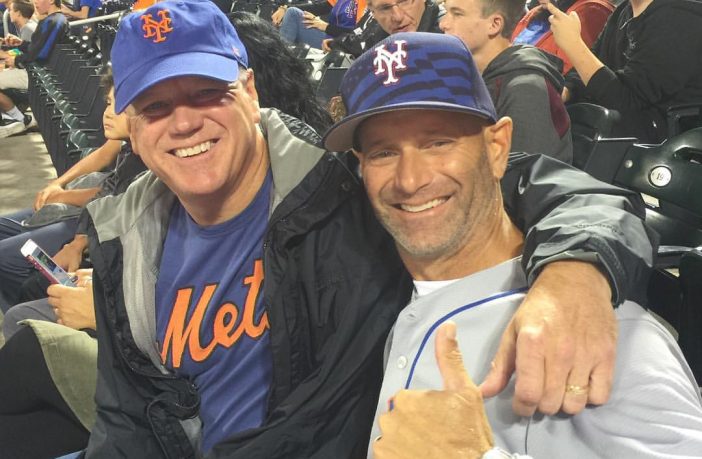by Dan Martinsen
This is a story of family and faith—about positivity in the face of adversity. It is about two “warrior angels”: my wife, Doreen Schmidt Martinsen, and my sister-in-law, Kelly McGrath Martinsen. It is, sadly, also about our country’s continued failure to respond to the acute need for registered organ donors. And it is the story of the amazing Drs. Jean Emond and Robert Brown and their teams at the Center for Liver Disease and Transplantation at New York Columbia Presbyterian Hospital who, 10 years ago this month, conducted their first living donor liver transplant surgery on a cancer patient to save his life (while Columbia had done hundreds of living donor liver transplants for progressive liver diseases, the hospital had never before used a living donor for a patient with cholangiocarcinoma). That patient was my younger brother, Kevin, and I was his living donor.
At shortly after 6 a.m., May 24, 2007, we were gathered in the operation prep area. There, Kevin and I stood, totally “rocking” our blue-green hospital gowns and tan, no-slip socks, both with an intravenous (IV) poll at our side. Kevin walked into the operating room for an exploratory procedure to check for cancer cells. If he were cancer-free, I would follow and our living donor transplant operation would proceed. However, if any cancer was detected, they would be forced to stop and pursue “other options.” Ninety minutes later, his surgeon appeared, dropped her mask and revealed a smile. No cancer cells! After hugs with my wife and family, in I went.
Earlier that year, Kevin was diagnosed with PSC (primary sclerosing cholangitis), a fairly rare liver disease. I vividly remember when we first talked about it: We were driving home from a New York Giants football game and he casually mentioned it. At the time, he was told it was in its very early stages and he might need a transplant way down the road. But in that moment while driving, one of those unexplainable silent voices went off in my head and said, “He will need a transplant, and you should get ready.” Usually, that voice tells me I forgot my keys or something. This was different.
A couple of months later, we received news that paralyzed our family. Kevin tested positive for bile duct cancer (cholangiocarcinoma), which is particularly virulent, with low survival rates. Fortunately, the cancer was detected very early and provided the opportunity for what was then a brand new approach: treat and kill the cancer cells with radiation and chemotherapy, and then replace the liver and common bile duct via transplant as soon as possible. But because Kevin was far down the organ waiting list due to the relative health of his liver, the cancer would have spread well before he would receive a cadaver liver. His doctors suggested the living donor option.
Kevin had the radiation and chemo but initially refused to allow us to be a living donor and was pursuing other options. Precious time was passing. Doreen then took charge and kicked our family in the ass. She fixed her electric blue eyes on me one night and said: “You guys have to snap out of it and stop waiting for Kevin to make a decision! We have to convince him to let one of us be the donor. This is real and we need to move fast!” Our family had never been faced with a true crisis before. But Doreen had, and her life experience gave her the strength to push us all forward.
Kevin finally relented, and I was tested first. The next month included physical and psychological tests to ensure we were a match and that Doreen and I fully understood what we were doing—the risks, etc. Doreen and I were repeatedly told that this procedure was “out of the box.” We would always respond: “Do you have any better ideas? No? Okay, let’s stop talking and go.” We had three kids, a house, jobs, etc., and Doreen did not waver for a second. We told our kids, all teenagers at the time, that their uncle needed a liver transplant and I was able to help him. Just like their mom, they were behind it 100 percent.
Going into surgery, I remember asking the team to do a good job, adding that while they were at it to feel free to make any improvements they saw fit. I got a rare laugh, and seconds later, I was asleep. Outside, Doreen, Kelly and our parents, then 71, waited 14 hours. We awoke to the news that the operation was successful and that they had removed about 70 percent of my liver and put it in my brother. The liver is the only organ that regenerates, and mine would grow back to near its full size. Alas, no other improvements.
During our recovery, Doreen and Kelly were tireless advocates while also working their jobs and taking care of our kids. They shared a dorm room and got up at 5 a.m. to get coffee, becoming mini celebrities with the local fire department that loved seeing these two crazy blondes walking up 168th Street in their pajamas in the dark. They kept our well-wishers at bay while we waited for our gastro systems to restart after the abdominal surgery. Yes, there were serious prayers for farts happening in the hospital chapel that week, and when they finally happened, the entire floor exploded in celebration! Meanwhile, Kevin and I would occasionally meet and walk the ward halls, once again rocking our gowns, no-slip socks and rolling IV polls.
Post-surgery, I experienced a bile leakage—a common complication from liver transplant surgery—and left the hospital with a drainage tube jutting out from my abdomen with a lovely rust-colored liquid that looked like old antifreeze flowing into a plastic jar. I temporarily lost 25 pounds, and for the first few weeks home I looked like Tim Conway’s character The Old Man from The Carol Burnett Show, shuffling around the house and neighborhood in my red bathrobe as my liver gradually regenerated and my strength eventually returned. By the fall, I was back at work and running 4 miles a day.
Ten years later, Kevin and my incisions are long healed. Since my day as “Donor #1,” in the cholangiocarcinoma setting, there have been countless others that have successfully served as living donors for cancer patients. But despite all of the amazing advances, the demand for organs continues to vastly exceed the number of donors, with a person being added to the national transplant waiting list every 10 minutes. Here in New York, only 27 percent of people age 18 and over have enrolled in the New York State Donate Life Registry as donors. Nationwide, the average is 50 percent.
Happily, Kevin is doing great, and he and Kelly are raising their two awesome kids, Dylan and Reagan, and ripping up the surf on Long Beach, LI, every chance they get. And in September, I’ll be walking my beautiful daughter Kathleen down the aisle to get married, with Doreen and the rest of our family all around us. Among them will be my now 81-year-old parents, spry as ever and ready to party and celebrate this wonderful gift that is life.
Nationwide, roughly 22 people die every day waiting for a liver transplant. To register to be an organ donor, visit OrganDonor.gov.
Source: Dan Martinsen is a freelance writer and strategic communications consultant. He is a former executive vice president of communications for Viacom’s Kids’ and Family Group. To support these brothers in their Liver Walk click on the link https://liverlifewalk.org/newyorkcity/support/#danmartinsen






